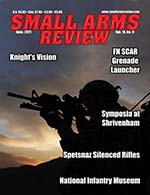By Dan Shea
Header photo, Left to right: UNS-SR is a night vision unit that utilizes 1 AA battery with a life exceeding 24 hours, mounts in front of almost any day optic that the rails will line up, and has recognition of a man-sized target out to 250+ meters in starlight. UNS is a night vision unit that utilizes 2 AA batteries with life expectancy exceeding 48 hours, mounts in front of almost any day optic that the rails will line up, and has recognition of a man-sized target out to 500+ meters in starlight. UNS-LRLP is a night vision unit that utilizes 2 AA batteries with life expectancy exceeding 48 hours, mounts in front of almost any day optic that the rails will line up, and has recognition of a man-sized target out to 800+ meters in starlight. UNS TLR is a Thermal vision unit that utilizes two DL123 batteries with life expectancy exceeding 5.5 hours, mounts in front of almost any day optic that the rails will line up, and has recognition of a man-sized target out to 800 meters, and UNS T is a Thermal vision unit that utilizes two DL123 batteries with life expectancy exceeding 5.5 hours, mounts in front of almost any day optic that the rails will line up, and has recognition of a man-sized target out to 1,000 meters. In front is FIST. This is the “Blended Technology” model that allows the operator to add in-line night vision and thermal capability with one unit that mounts in front of the day scope. FIST uses two DL123 batteries with a full “On” life expectancy of six hours. The thermals can detect a man-sized target at 1,000 meters, and the night vision capability extends beyond 800 meters for a man-sized target in starlight.
C. Reed Knight, Jr. is a name that is very familiar to readers of SAR. Reed has been at the forefront of special weapons technologies for decades, working with the likes of Gene Stoner and many other modern designers on programs from the Knight suppressors to the rail forends used by much of the U.S. Military today, as well as the MK11 Mod O and M110 SASS rifles.
Never one to sit back on his laurels, Reed put his engineering team onto a problem that he saw over his 25-plus years dealing with government needs. Knight's Armament has been involved in the development of night vision opto-electronics since 1991, when they were the test facility for SOTF. They evolved their participation into JSOC, and other groups within the U.S. government. It didn't take too long before Reed and his engineering team decided that they had the necessary skills, facility, and equipment to solve the problems they were seeing.
The first problem was the night vision equipment was divided into two main categories: standalone vision aids, and dedicated opto-electronic weapon scopes. The two were not interchangeable, and Knight's was the first group to create the in-line night vision system. This allowed the operator to install his night vision device in front of the standard day optic for night use, and with Knight's design, it kept the point of aim within .5 MOA. There is a shift that occurs when putting a night vision opto-electronic device in front of a straight optical one, and Knight's successfully adapted to this. A second problem was that most manufacturers of opto-electronic gear were specialists in their field, and had little experience with firearms and the shock/ mount problems and recoil effect. Knight's was uniquely qualified to address these issues due to the decades of firearms experience and engineering in the facility.
The latest optics solution that has entered the combat theatre is the new Thermal Weapon Sights (TWS) and their presence has added a third component to the soldier's kit. Now the soldier would have a day sight, a night sight, and a thermal sight. With Knight's first engineering solutions, the operator can use his day sight, and when needed simply attach his night vision device in front of it on the rail and there will be virtually no point of impact shift.
Knight's second solution was to work towards "blended technologies," meaning some of the opto-electronics offered from Knight's are a night vision device combined with a thermal weapon sight, and the operator can select his choice of operation on the one blended unit while it is mounted in front of his day optic. The operator can choose day sight only, night vision, and night vision enhanced with thermal using "white as hot," or using "black as hot."
Knight's has also pioneered the removal of film that was being sandwiched into the lenses, and these innovations are allowing the removal of the "Halo" effect that blurs up the detail. For more information, please contact the manufacturer:
Knights Armament Company
701 Columbia Blvd,
Titusville, FL 32780 USA
Tel: (321) 407-9900
www.knightarmco.com
This article first appeared in Small Arms Review V14N9 (June 2011) |
| SUBSCRIBER COMMENT AREA |
Comments have not been generated for this article.



